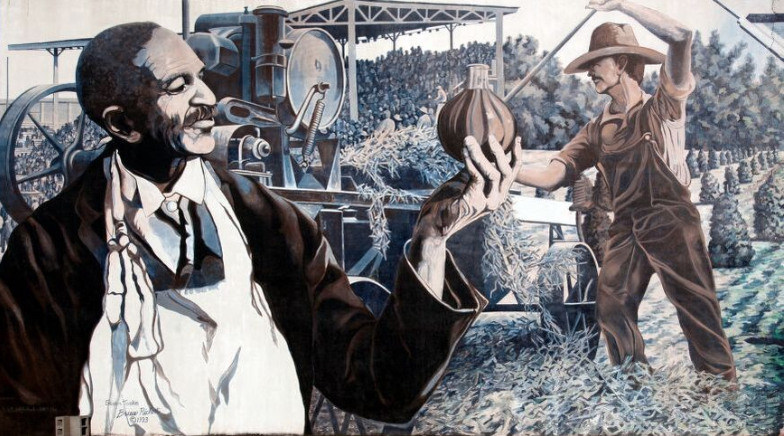Teach This Poem is a weekly series featuring a poem from our online poetry collection, accompanied by interdisciplinary resources and activities designed to help K-12 teachers quickly and easily bring poetry into the classroom.


The following activities and questions are designed to help your students use their noticing skills to move through the poem and develop their thinking about its meaning with confidence, using what they’ve noticed as evidence for their interpretations. Read more about the framework upon which these activities are based.
- Warm-up (quick write): If you could invent one thing that would improve the world, what would you invent? Why?
- Before Reading the Poem (noticing and pair share): Look carefully at the image of the mural titled “Salute to the Peanut Industry.” What immediately grabs your attention? Why? Why might this mural have been painted? Who might the audience for this mural be? Why? Now, look at the second image of the mural here. This is a zoomed-in image of the same mural. Now, what do you notice about this image? How does it compare to the first image? What do you wonder about these images?
- Reading the Poem: Read the poem “Notes on the Peanut” by June Jordan silently. What do you notice about the poem? Annotate for any words or phrases that stand out to you or any questions you might have. (Teachers, you may wish to give students dictionaries to use as they read this poem.)
- Listening to the Poem (enlist two volunteers to read the poem aloud): Listen as the poem is read aloud twice, and write down any additional words and phrases that stand out to you. Call back the lines that you like by saying these lines aloud with a partner or your tablemates.
- Small-group Discussion: Share what you noticed in the poem with a partner and another pair of students. Based on these details you just shared with your small group, how might the images from the beginning of class relate to the poem? Why?
- Whole-class Discussion: (Teachers, if your students need more context about George Washington Carver, this short article outlines some of his major accomplishments.) How do these two lines compare: “lowly peanut” and “potential of this lowly leguminous plant”? Who might the audience be for this poem, or who is the speaker talking to? Why? The poem uses hyperbole. What is one surprising example of hyperbole?
- Extension for Grades 7-8: Read George Washington Carver’s pamphlet “How to Grow the Peanut: 105 Ways of Preparing It For Human Consumption.” Create an informational brochure about the peanut that combines George Washington Carver’s language and June Jordan’s language. Feel free to add your own creative language.
- Extension for Grades 9-12: Research more about African American inventors. Choose one inventor and write a poem, speech, or song that honors this inventor in a unique way. Share your inventor and original piece of writing with the class. Or, write the next poem. The last three lines of the poem are: “Please / Speak right into the peanut! // Your name?” What do you want to say?
More Context for Teachers
June Jordan was born in New York City in 1936. She was the author of numerous books of poetry, including We’re On: A June Jordan Reader (Alice James Books, 2017). Jordan was also known for her political essays and her activism. She died in 2002.
